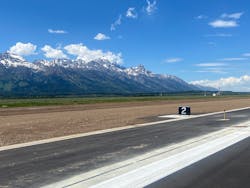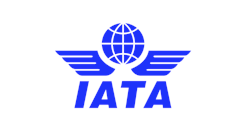Collaboration Key to JAC's Improved Water Collection Process
Jackson Hole Airport (JAC) takes its position as the only commercial service airport inside a national park seriously.
Jackson Hole Airport Board Executive Director Jim Elwood, AAE said the airport holds itself to a higher environmental standard than federal regulations dictate and growing this mission when tackling improvement methods. So when JAC undertook a complete rebuild of its runway, leaders took the opportunity to expand its water collection system with the installation of slot drains along the new pavement.
“We get between 160 inches to sometimes 250 inches of snow per year,” Elwood said. “We know there’s millions of gallons of water that would not normally go through the water filtration system unless we were able to collect it.”
Rebuilding JAC
Airport officials began planning for a major runway reconstruction about six years ago after an analysis showed the runway’s subbase has failed. Parts of the subbase dated to the 1970’s and was located 5 feet below grade, meaning the 6,000-foot runway would need to be shut down for the $43.8 million rebuild.
But the tourist nature of the Jackson Hole area meant they had a very short time to perform the task — 78 days.
“It sat between the closure of the Jackson Hole Mountain Resort ski season and Fourth of July weekend, which is the ramp up of busy season in the community,” Elwood said.
It took six years to plan the project down to very fine detail. A 24-hour workday was planned for each day of the 78-day closure, with each day broken into four-hour work sections.
All non-weather dependent modules of the rebuild were identified beforehand so the contractor would be able to move these up when bad weather occurred. The contractor didn’t lose a single day of work.
“We really pushed the envelope in terms of the quantity of work and how much could be done in a given day and making sure it matched up with the capabilities of contractors,” Elwood said. “And we ran into some of the most difficult weather that Jackson Hole has seen in 40 years in terms of snow, cold and rain.”
How to Collect More Water
JAC made an investment in a water collection and filtration system five years ago to collect all water on hard surfaces at the airport. The water is collected off the ramps, roofs, parking lots and roadways at JAC, then sent to a water filtration system located on the south end of the airport.
All of the collected water is treated before released to remove contaminants.
“The natural extension was also to add the capacity and capability that comes off that surface on the runway,” Elwood said. “Water on the runway can have different things in it, so it’s not in the best interest to not treat it.”
The airport board committed to installing 29,000 linear feet of slot drains along the runway. They run immediately adjacent to the runway pavement and outside the shoulder of the runway. This allows JAC to collect water from snow plowed off the runway and as it melts.
Slot drains provide a long horizontal product encased in concrete to allow for easier maintenance. Water comes in from two directors while the small grate size and length of the drain make it less susceptible to clogging.
A slot drain lies up to one-quarter of an inch below the surface levels, so snow removal equipment won’t get hung up on the unit. Slot drains are available in plastic, metal and concrete. Steel was chosen for JAC because it’s strength and it is the most sustainable of the three options.
“The product at the Jackson Hole airport ordered is probably the beefiest that we can design and manufacture,” said Rob Chapman, director for Contech Engineered Solutions. “Traditionally it's aluminized Type 2 steel with the grate in it. This application had a polymeric film. That just gives it a little bit extra durability to get that service life to last well beyond their next few runway rehabs they do.”
Contech’s slot drain system was chosen for the JAC project. The contractor and engineer were brought to Contech’s facility in Indiana so they could see the materials and provide design input to have knowledge of the system before installation.
“Cost, speed of installation, long term durability and strength were all important," Bob Moore, Region Engineer for Contech said. “The steel product met all those requirements that they were looking for. It was just the best fit for the job."
The contractor installed a small section of slot drain the summer before the project to test it.
Once proven it allowed Contech to move forward with building the system.
“They put in a couple thousand feet to get an idea of their installation capabilities. It was still an active runway at that time, so they were installing between 11 p.m. to 5:45 a.m.,” Chapman said. “They had smaller nighttime windows where they got heavy equipment to install this in sections to get an idea of how much footage per day that could put in the ground.”
It took Contech five months to manufacturer the system for JAC. The company contended with supply chain issues and needed to ensure it was able to get the necessary materials to be ready in time for the installation.
“We were placing our steel orders many months in advance,” Chapman said. “When they contacted us to potentially supply the slot drains, we had to start investigating raw material sources at our steel mills to make sure that they could supply enough material in a timely fashion so we could get started soon enough in order to get everything completed, bundled on time and then ready to ship.”
A Team Effort for Success
The entire project faced a fast and ridged timeline for completion along with additional weather challenges. Jackson Hole got 5 inches of snow the first day the runway closed, so airport crews had to plow the airfield so the contractor could see engineering marks.
Elwood said weather issues were constant throughout the project, but airport staff assisted contractors with any help they needed, set up a quiet room for workers inside JAC’s fire station and shared the importance of the work being completed with the community.
“I’ve been doing projects at airports going on 40 years and without question this is the most collaborative project that I’ve had the honor of being part of,” Elwood said.
Knife River used proprietary techniques to install the slot drain system on time, with Contech providing additional information to assist with potential challenges along the way.
“We provided our expertise and they modified it to fit them,” Moore said. “There was a lot of idea sharing on our end so we could be a valuable resource for the contract and engineer of record.”
Elwood said developing a true partnership was key to accomplishing the project. You have to build a collaborative environment with strong communication to ensure all of the stakeholders understand the various elements of a project and find ways to support each other throughout the program.
“Plan everything you can before a project,” he said. “If you plan well, the project has a much better chance of being successful.”




